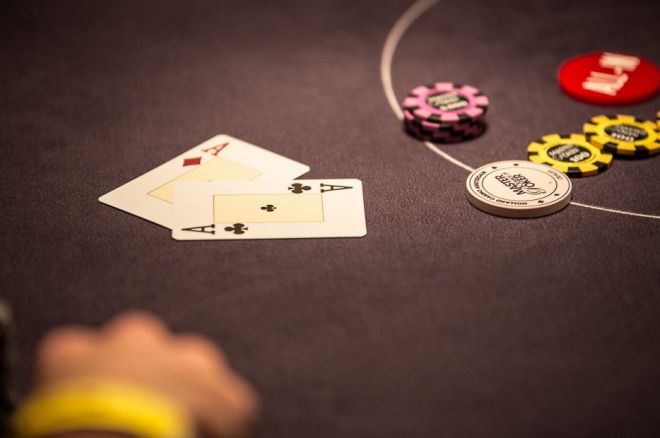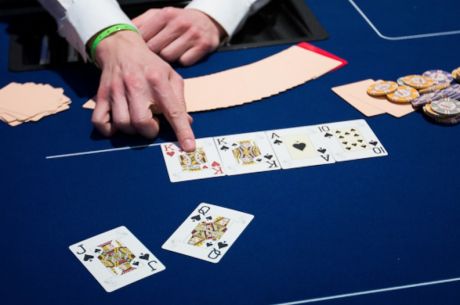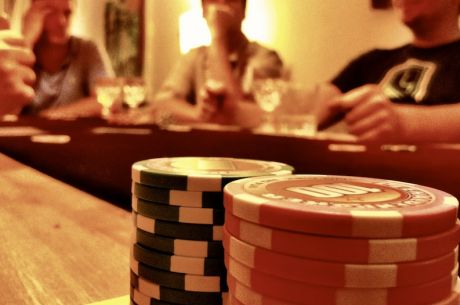“Aces Cracked” Promotions: Do You Go for the Pot or the Bonus?

I have previously written about how to adjust one’s strategy when playing in a poker room that offers high-hand jackpots. (Short answer: Not at all.) Let’s take a look at the strategy for playing hold’em under another common promotion — “aces cracked.”
Like all promotions, this one will usually be found only in low-stakes games. The basic idea is that you get some sort of bonus if you are holding pocket aces and lose the hand. One hundred dollars is the amount I have most commonly seen, though it might be as small as $25. The stipulations for getting the money are...
- you have to play the hand all the way out to showdown, and
- you may not discuss or otherwise reveal to other players the fact that you have aces.
Unfortunately, the latter rule is frequently ignored by players and unenforced by dealers. At Las Vegas casinos that have “aces cracked” promotions on a regular basis, gangs of nitty locals show up, playing only the hours of the promotion, and use a variety of subtle and not-so-subtle signals to tell the table that they have aces and want a cheap showdown with many opponents. All the others in the know cooperate, with the understanding that they will get the same treatment when they have the aces.
This is dishonorable. If you see this going on, you should not join in, but find another place to play poker. On your way out, inform the floor of what you witnessed. In reality, they almost surely know about it — which is exactly why you should take your business elsewhere. Do you really want to play in a poker room that knowingly tolerates cheating?
Moving on to the non-cheaterpants approach to playing under an aces-cracked promotion, there are two basic strategies you can choose.
First, you can just ignore the bonus, play the hand straight, and take the promotion money as a consolation prize if you lose.
Second, you can play completely passively, limping and calling as necessary, trying to minimize the amount you put into the pot and maximize the number of opponents. You are trying to lose the pot and claim the bonus instead. Let’s call these two approaches “Strategy A” and “Strategy B.” Which is better?
Unfortunately, there is no straightforward way to figure this out mathematically — which is why if you’re playing while such a promotion is in effect, it’s almost inevitable that you’ll hear at least one argument about A versus B. The problem is that old Catch-22 of poker: “it depends.” That remains true even if we specify the stakes of the game.
Your expected value (EV) of Strategy A depends on how aggressively you play, how accurately you read and respond to evidence that you’re beat, the kind and magnitude of mistakes your opponents make, what percentage of starting hands they call a raise with, effective stack sizes, and so on. We can be sure that the EV is a positive number (unless you misplay aces habitually), but it’s hard to say more than that.
We can imagine some extreme situations where the A/B decision would be clear. Suppose the bonus were $1,000, and you’re playing $2/$4 limit with a table full of passive opponents. You would surely find that Strategy B pays more over the long run.
Conversely, if the bonus were just $10 in a $1/$2 no-limit against a bunch of bad players who would routinely lose their $300 stacks to you with lesser one-pair hands, clearly Strategy A would be the way to go.
Let’s try to get a bit more concrete. If hold’em hands are played out to the river, how do pocket aces fare against numerous opponents? Here is a table of the winning percentages against random hands:
| Number of opponents | Aces win |
|---|---|
| 1 | 85% |
| 2 | 73% |
| 3 | 64% |
| 4 | 56% |
| 5 | 49% |
| 6 | 44% |
| 7 | 39% |
| 8 | 35% |
| 9 | 31% |
Of course, as soon as players make a decision to play instead of fold, you’re no longer up against random hands — they have been selected for play, by whatever screening criteria your opponents might employ. But it’s a start.
The table immediately suggests the appeal of the illegal cooperation plan, which is basically an idealized form of Strategy B. If you can get nine other players to limp in with you for a $2 big blind, and check every subsequent street no matter what comes, your EV is about $72 every time you have aces — most of it from the bonus, plus a little from winning some small pots. That might well be more than the EV of Strategy A.
But we’re assuming no cheating here, which means that you’ll almost never be given such deferential treatment with Strategy B. You may want to keep the pot as small as possible, but other players usually won’t see it that way. Their raises will drive out the weakest starting hands, and Strategy B will require you to keep calling bets and raises to the river. How much they charge you to try to lose at showdown will make a ton of difference to your EV.
For that reason, Strategy B tends to be more prevalent in limit games than in no-limit games, because losses tend to be smaller and more manageable, except for the rare situation of being trapped in a raising war between two other players.
For the no-limit games that I prefer, I decided a long time ago to go with Strategy A — i.e., the “play the hand straight” approach. I suspect that it is generally more profitable, though that is unprovable because of all of the variables involved.
I think going with Strategy A is also better defense against tilting. I find it frustrating to slow play, trying to lose, only to end up winning a tiny pot that could have been much bigger had I been more aggressive.
Even worse is when you end up in a situation where you have to call a large river bet to qualify for the bonus, even though you are sure that you’re losing.
Suppose there’s a flush or straight on the board, your aces have not improved, and your only opponent, who never bluffs, pushes all-in for $90. There is $50 in the pot from previous betting, half contributed by each of you. Mathematically, you have to call in order to get the $100 bonus, even though you will end up with a net loss for the hand; your loss is $25 if you fold, but only $15 if you call and lose.
In other words, in a no-limit game, it’s not rare to find yourself earning the bonus you were seeking, but still taking a net loss on the hand. I hate that so much. Meanwhile if I play the hand without thought for the bonus, and take it simply as a way to reduce losses when I lose at showdown, I find the whole thing much less emotionally irritating.
Frankly, I think the best strategic approach to an “aces cracked” promotion is neither A nor B. Instead, just walk away and find a casino not offering a bonus that so badly distorts how the game is played. I think both your bankroll and your sanity will be better off.
Robert Woolley lives in Asheville, NC. He spent several years in Las Vegas and chronicled his life in poker on the “Poker Grump” blog.
Want to stay atop all the latest in the poker world? If so, make sure to get PokerNews updates on your social media outlets. Follow us on Twitter and find us on both Facebook and Google+!








